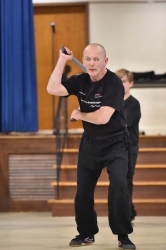
In the world of mixed martial arts (MMA), George St-Pierre, often referred to as GSP, stands as a shining example of how traditional martial arts can be seamlessly integrated into the modern sport of MMA. Throughout his illustrious career, St-Pierre showcased the effectiveness of traditional martial arts techniques, blending them with modern training methods to become one of the greatest fighters in the history of MMA.
The Early Influence of Traditional Martial Arts
George St-Pierre’s journey into the world of martial arts began with his father’s guidance into Kyokushin karate. This traditional Japanese martial art formed the foundation of his fighting style. Under the tutelage of his teacher Jean Couture,, St-Pierre developed exceptional striking skills, emphasizing strong kicks and precise strikes – a hallmark of Kyokushin karate.
His early training in Kyokushin not only instilled in him the values of discipline and respect but also gave him a solid base in stand-up combat. This traditional martial art teaches practitioners to utilize their entire body in strikes, promoting a well-rounded approach to striking in MMA.
Evolution of Striking
As St-Pierre transitioned to professional MMA, his striking game evolved significantly. He incorporated elements of boxing and Muay Thai, two striking arts known for their effectiveness in combat sports. By combining traditional martial arts techniques with these modern striking disciplines, St-Pierre became a dynamic and unpredictable striker inside the octagon.
His ability to blend traditional karate kicks with the powerful punches of boxing and the devastating elbows and knees of Muay Thai made him a formidable opponent. This diverse striking arsenal allowed him to control the distance, dictate the pace, and create openings for takedowns and ground control – a strategy that became his trademark.
Wrestling and Ground Control
While St-Pierre’s striking skills were impressive, he recognized the importance of being well-rounded in MMA. To complement his striking, he delved into wrestling, a martial art known for its takedown and ground control abilities. His dedication to wrestling helped him become one of the best wrestlers in the welterweight division.
St-Pierre’s wrestling skills allowed him to dictate where the fight took place. He could choose to keep it standing, where his striking prowess shone, or take it to the ground, where he could employ his BJJ skills. This wrestling foundation, combined with traditional martial arts principles of balance and leverage, made him a dominant force in MMA.
Brazilian Jiu-Jitsu Mastery
In the world of traditional martial arts, George St-Pierre also embraced Brazilian Jiu-Jitsu, a grappling art known for its effectiveness in submissions and ground control. St-Pierre’s journey in BJJ was marked by constant improvement and dedication to the craft.
His ability to seamlessly transition between striking, wrestling, and BJJ was a testament to his martial arts versatility. St-Pierre used his traditional martial arts discipline and adaptability to neutralize opponents on the ground, control positions, and execute submissions when opportunities arose.
Legacy of Traditional Martial Arts
George St-Pierre’s career serves as a testament to the enduring value of traditional martial arts in modern MMA. He proved that traditional martial arts can be the foundation upon which a fighter builds a complete skill set. By embracing and evolving these techniques, he achieved incredible success, becoming a two-division UFC champion and one of the sport’s all-time greats.
St-Pierre’s legacy extends beyond his numerous titles and records. He inspired a new generation of fighters to appreciate the effectiveness of traditional martial arts in MMA. His dedication, discipline, and commitment to refining his skills showcase the enduring influence of traditional martial arts in the evolution of combat sports.
- Writing for Martial Journal; From the Editor - April 29, 2024
- Katheryn Winnick: A Warrior on Screen and in Life - April 14, 2024
- Celebrating Harmony: World Tai Chi and Qi Gong Day, April 27, 2024 - April 10, 2024

Leave a Reply